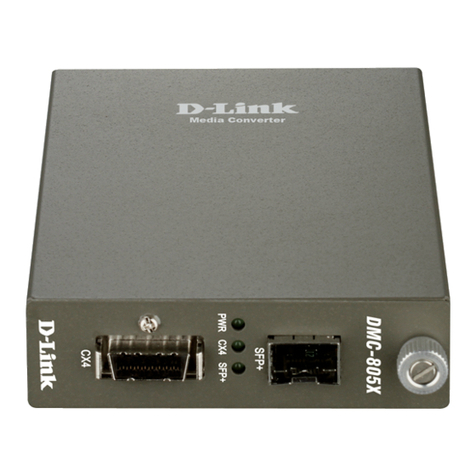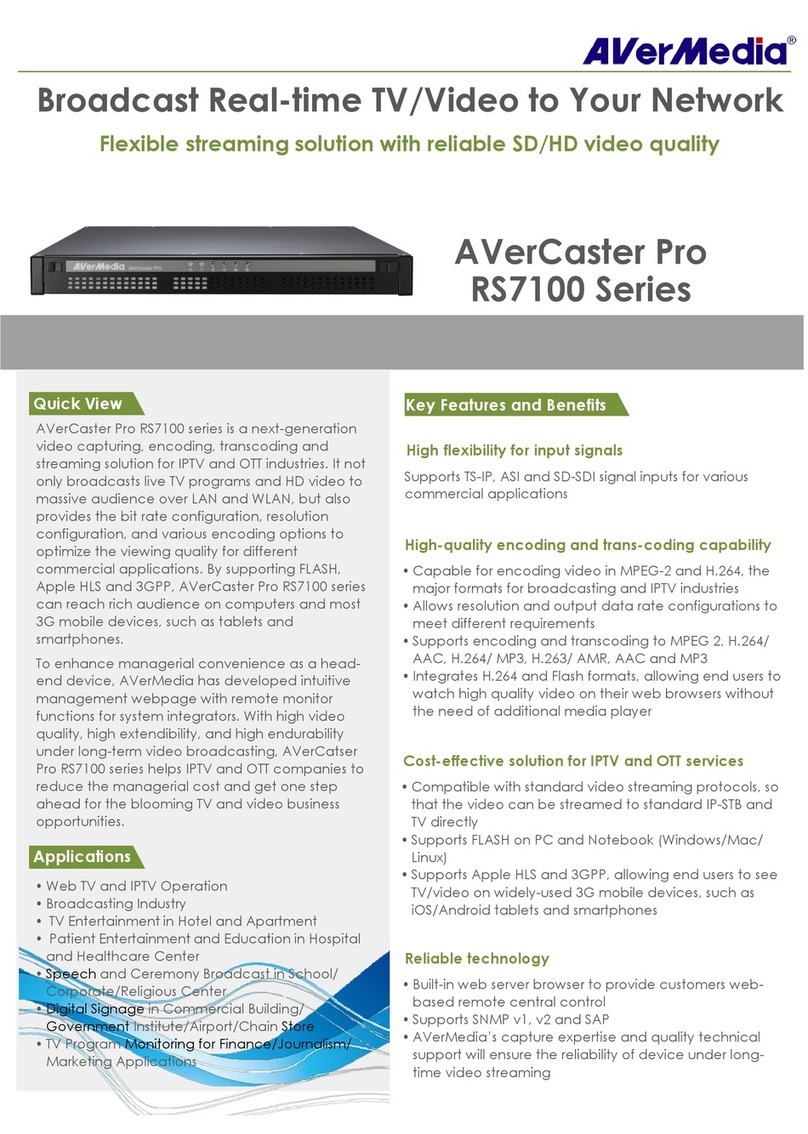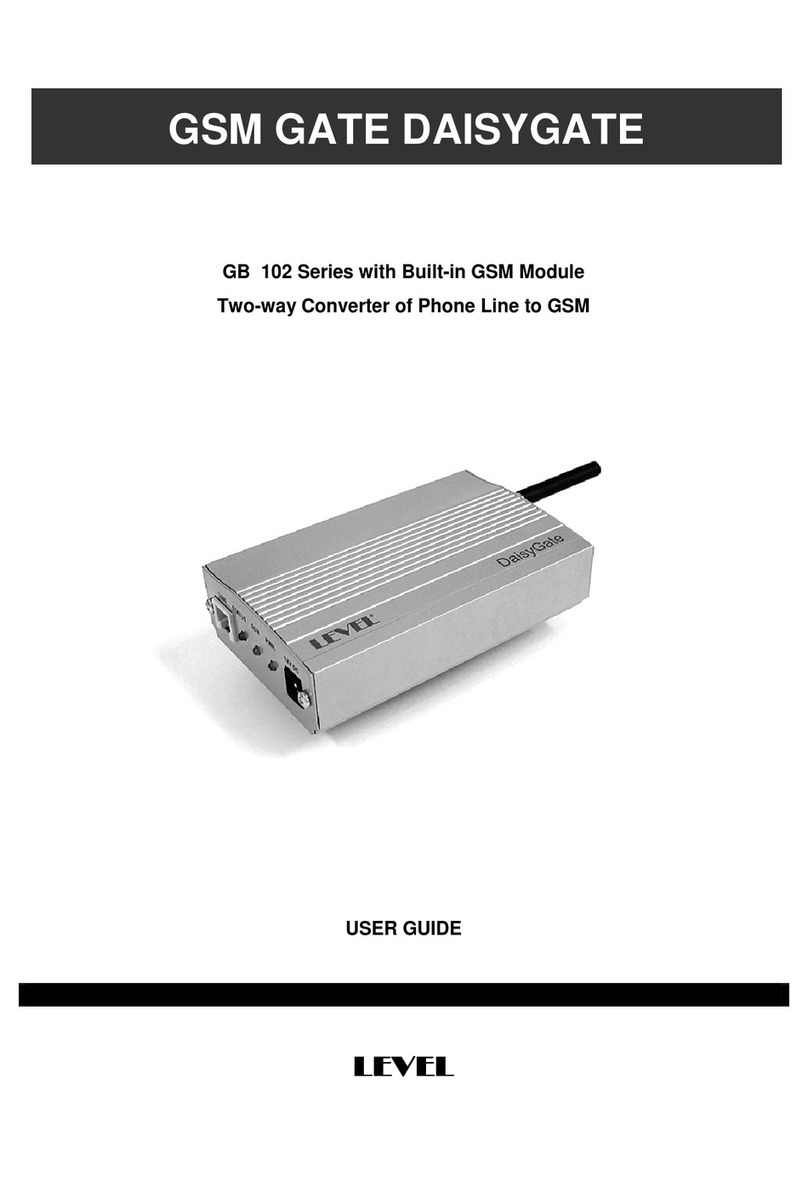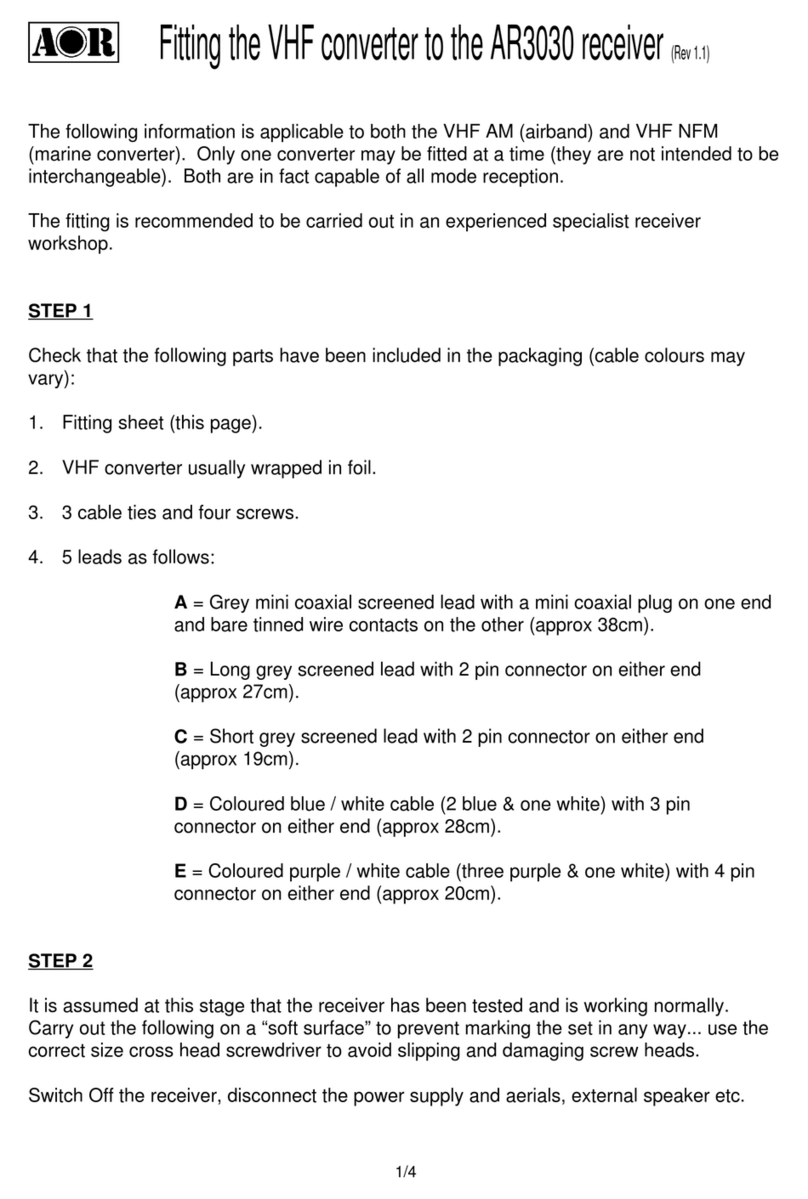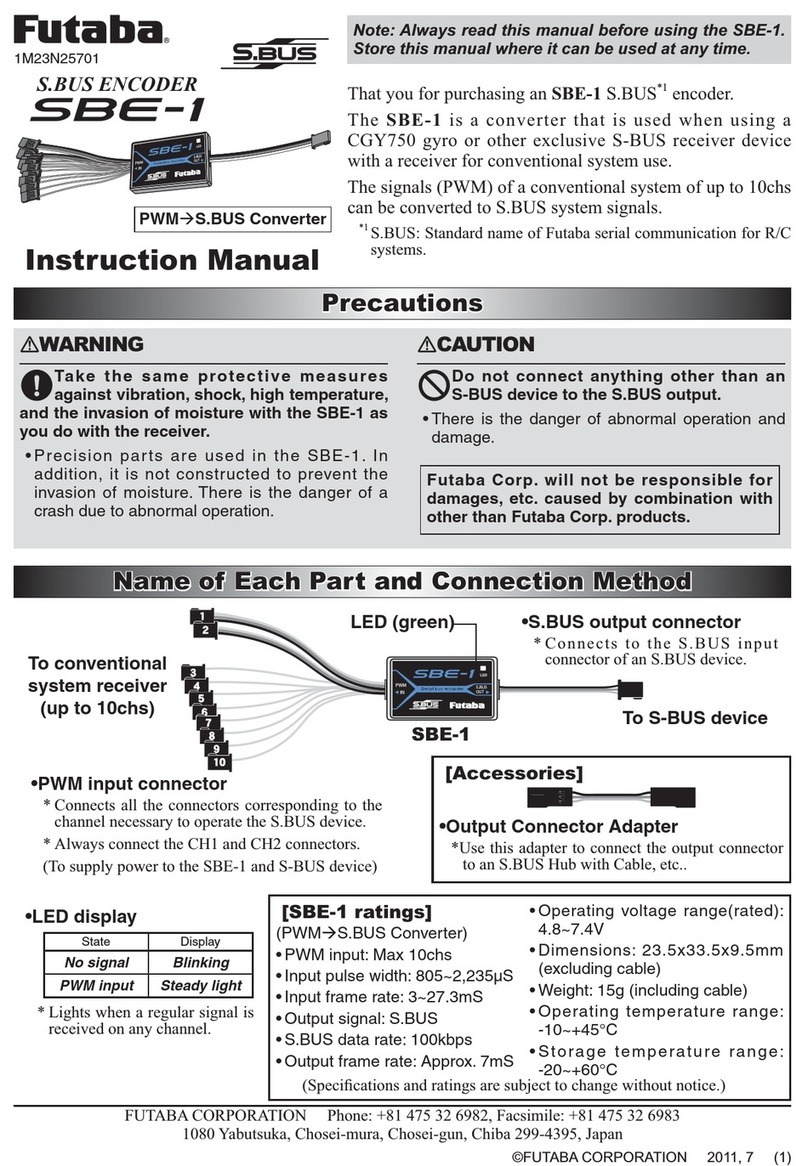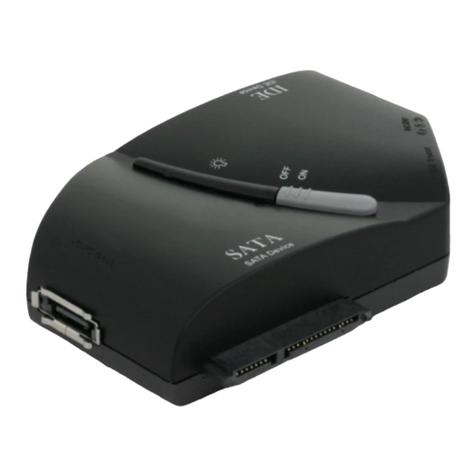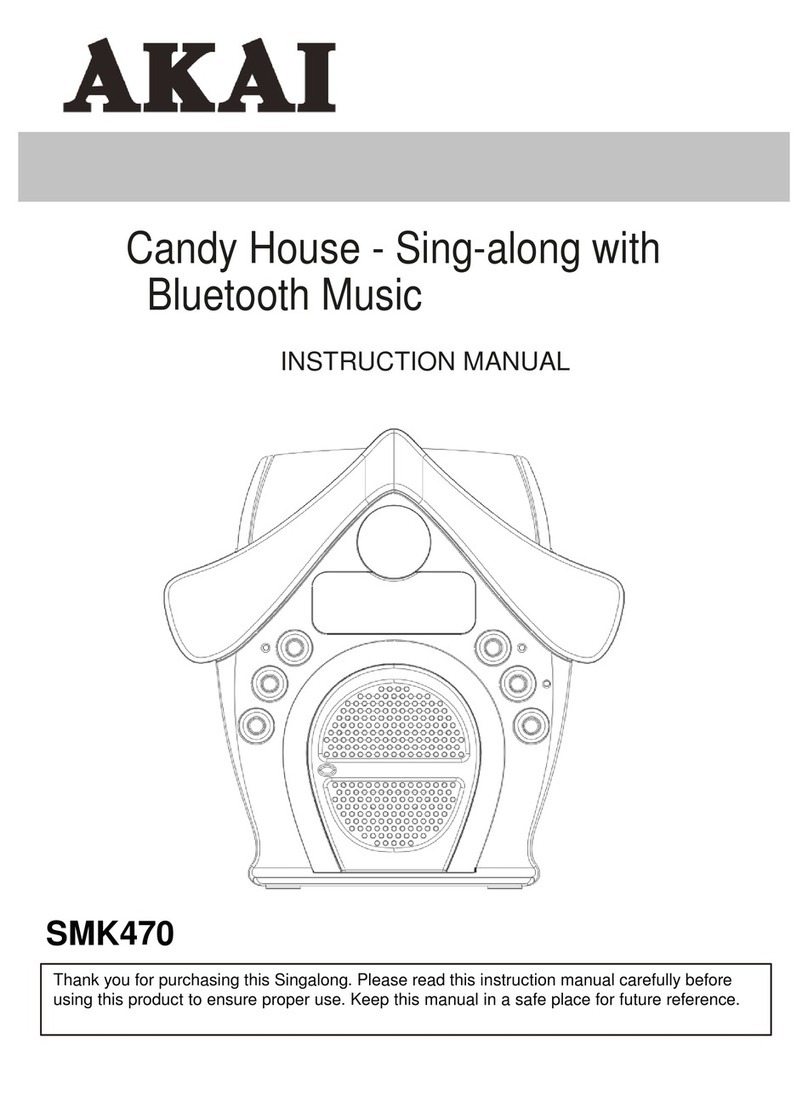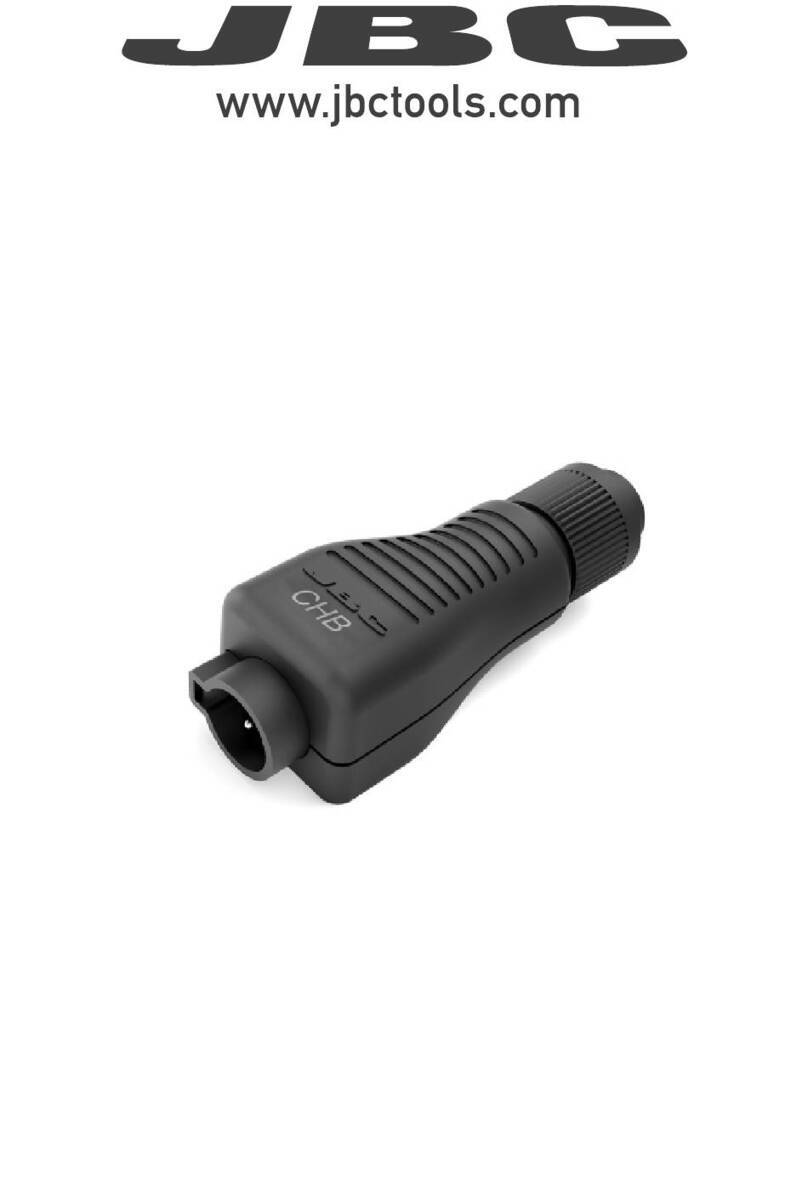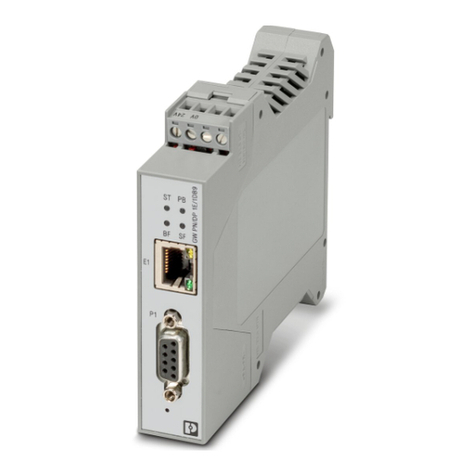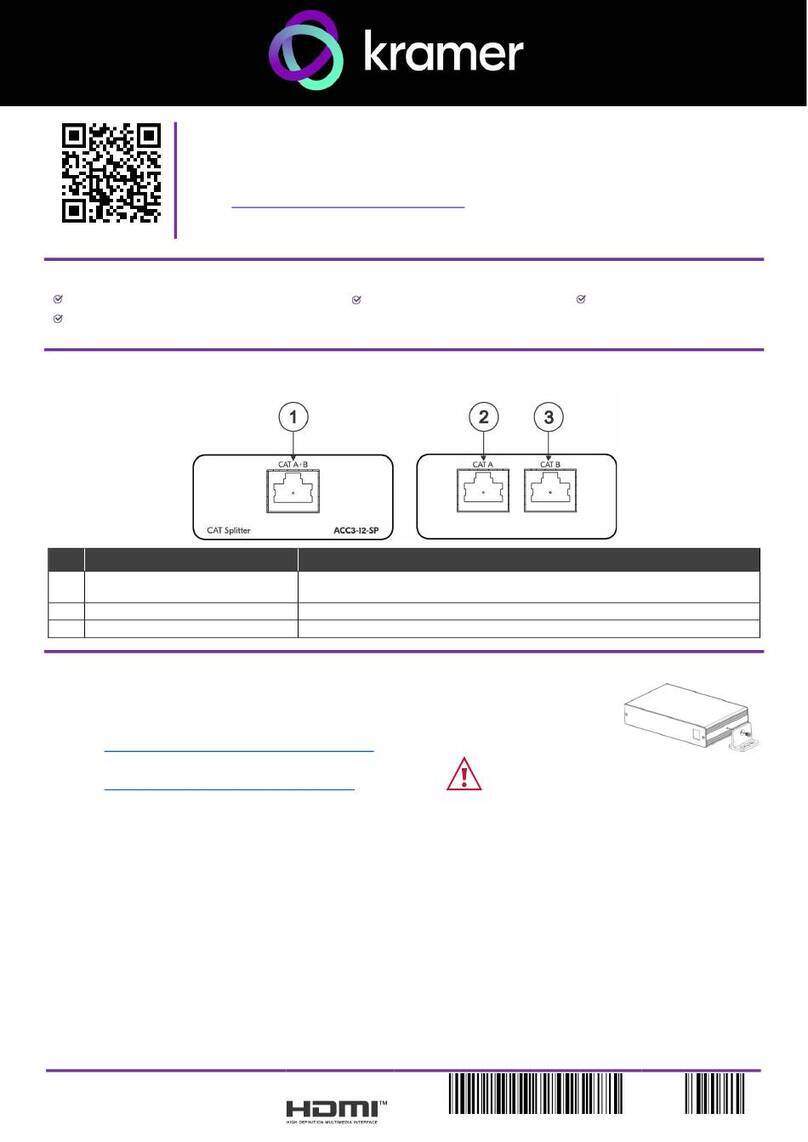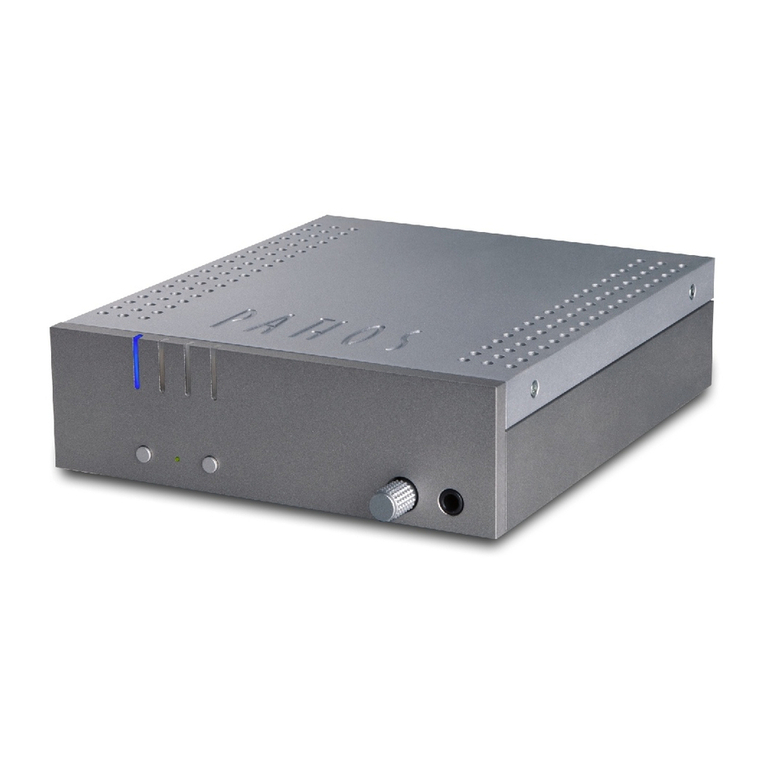Tiernan TE3000 Operating instructions

A Radyne ComStream Company
6340 Sequence Drive San Diego, California 92121
phone: 858.587.0252 fax: 858.587.0257
TPN: 505-010690-0001 Rev.C 07/02/01
TE3000
MPEG-2 DSNG Encoder
Installation and Operation Guide

Notice
This manual and its contents are proprietary to Tiernan Radyne ComStream, Inc. (Tiernan) and are intended solely for the contractual use of its
customers for no other purpose than to install and operate the equipment described herein. This manual and its contents shall not be used or
distributed for any other purpose and/or otherwise communicated, disclosed, or reproduced, in any way whatsoever, without prior written
consent of Tiernan.
Only experienced personnel should install and/or operate this equipment. Prior to installing or operating any equipment or parts thereof,
personnel must carefully read and understand all of the contents of this manual. To properly install and operate this equipment and/or all parts
thereof, personnel must strictly and explicitly follow all of the instructions in this manual.
FAILURE TO COMPLETELY READ AND FULLY UNDERSTAND AND FOLLOW ALL OF THE CONTENTS OF THIS MANUAL PRIOR TO INSTALLING AND/OR
OPERATING THIS EQUIPMENT, OR PARTS THEREOF, MAY RESULT IN INJURY TO PERSONNEL AND/OR DAMAGE TO THE EQUIPMENT, OR PARTS THEREOF.
Tiernan does not assume any liability arising out of the application or use of any products, component parts, circuits, software, or firmware
described herein. Tiernan further does not convey any license under its patent, trademark, copyright, or common-law rights nor the similar
rights of others. Tiernan further reserves the right to make any changes in any products, or parts thereof, described herein without notice.
©2001 Tiernan Radyne ComStream, Inc. All rights reserved.
Tiernan Radyne ComStream is a registered trademark. Other brand and product names mentioned herein may be trademarks or registered
trademarks of their respective owners.
Contents are provided with RESTRICTED RIGHTS. Use, duplication, or disclosure by the government is subject to restrictions as set forth in
subparagraph (c) (1) (ii) of the Rightsin Technical Data and Computer Software [OCT. 1988] clauseat DFARS 252.227-7013 and
subparagraphs (a) through (d) of the Commercial Computer Software-Restricted Rights [JUNE 1987] clauseat FAR 52.227-19, as applicable.
Manufacturer is Tiernan Radyne ComStream, Inc., 6340 Sequence Drive, San Diego, CA 92121 USA.
Contents of this manual are provided as is without warranty of any kind, either expressed or implied, including, but not limited to, the implied
warranties of merchantability, fitness for a particular purpose, and non-infringement.
Content could include technical inaccuracies or typographical errors. Changes are incorporated in new editions of this manual. Tiernan may
make improvements and/or changes in the product(s) and/or the program(s) described in this manual at any time without notice.
In no event will Tiernan be liable for direct, indirect, special, incidental, economic, cover, or consequential damages arising out of the use or
inability to use the contents even if advised of the possibility of such damages. Some jurisdictions do not allow the exclusion or limitation of
implied warranties, or the limitation of liability for incidental or consequential damages, so the above limitation or exclusionmay not apply to you.
For further information on legal and intellectual property matters, contactTiernan Radyne ComStream Corporate Counsel.
This equipment has been tested and found to comply with the limits for a Class A digital device, pursuant to part 15 of the FCC Rules. These
limits are designed to provide reasonable protection against harmful interference when the equipment is operated in a commercialenvironment.
This equipment generates, uses, and can radiate radio frequency energy and, if not installed and used in accordance with the instruction
manual, may cause harmful interference to radio communications. Operation of this equipment in a residential area is likely to cause harmful
interference in which case the user will be required to correct the interference at his own expense.
WARNING! Electric Shock Hazard
Do Not Open The Equipment!
Service Only by Tiernan Radyne ComStream, Inc.
Gefährliche Spannung!
Öffuen des Gerätes und Service nur dur Tiernan Radyne ComStream, Inc.
The TE3000 contains no user-serviceable parts. Do not attempt to service this product
yourself. Any attempt to do so will invalidate any and all warranties.
DANGER!
Electric Shock
Hazard

Contents i
Contents
Preface Using This Manual ...............................................................................................iii
Customer Service ..................................................................................................v
Product Shipments .................................................................................................v
Warranty Information ............................................................................................v
Other Tiernan Products ......................................................................................... v
Safety Precautions ................................................................................................vi
Chapter 1 TE3000 Overview ....................................................................................1
Features ................................................................................................................. 1
Network Management Software ............................................................................ 3
Chapter 2 Installing the TE3000 ..............................................................................5
Placement ..............................................................................................................5
Powering On The TE3000 .....................................................................................5
Rear Panel Connections ........................................................................................7
Video Ports ......................................................................................................7
Audio Ports ..................................................................................................... 8
Aux Data A and B Ports .................................................................................9
Remote Unit Connections ............................................................................. 12
DTE/DCE Switch ......................................................................................... 14
Fault Relay .................................................................................................... 14
Transport Connection Ports ................................................................................. 15
Modulator Output to Upconverter Connections ..................................................16
Chapter 3 Using the Front Panel ...........................................................................17
Front Panel Components .....................................................................................17
Navigating Through the Menus ........................................................................... 19
LCD Display .......................................................................................................19
Front Panel Navigation Buttons .......................................................................... 20
Issuing Commands .............................................................................................. 23
Modulator Control Buttons ................................................................................. 25
Front Panel Menu Descriptions ........................................................................... 26
TE3000 Procedures ............................................................................................. 38
Chapter 4 Using a Remote Unit .............................................................................43
Configuring the Remote Control Software Parameters ....................................... 43
Ethernet Port ........................................................................................................ 44
Remote Communications Overview ................................................................... 45
Issuing Remote Commands ................................................................................. 46

ii Contents
Error Messages ....................................................................................................48
Remote Command Descriptions ..........................................................................49
Chapter 5 Configuring the TE3000 ....................................................................... 63
TE3000 Configuration Procedure ........................................................................63
Setting a Default Configuration ...........................................................................63
Configuration Examples ......................................................................................65
Chapter 6 Troubleshooting ................................................................................... 73
Fault Reporting and Monitoring ..........................................................................73
Status LED ..........................................................................................................73
Current Faults ......................................................................................................73
Fault History Log ................................................................................................75
Fault Relay Monitoring .......................................................................................76
Initialization Self-Test Function ..........................................................................77
Fault Summary ....................................................................................................78
Operational Problems and Possible Solutions .....................................................81
Chapter 7 Maintenance and Software Upgrades ................................................. 83
Appendix A Technical Specifications ...................................................................... 85
Appendix B IF Looptest ............................................................................................ 87
Required Equipment ............................................................................................87
Setting Up the TE3000 ........................................................................................87
Powering the Equipment .....................................................................................88
TE3000 Looptest Configuration ..........................................................................88
IRD Looptest Configuration ................................................................................90
Performing the IF Looptest .................................................................................90
Testing the TE3000 Operational Features ...........................................................90
Appendix C TE3000 PID Assignments .................................................................... 91
Appendix D Table Top and Rack Mount Installation Instructions ........................ 93
Table Top Instructions .........................................................................................93
Front Rack Mount Instructions ............................................................................93
Rear Rack Mount Instructions .............................................................................94
Safety Precautions ...............................................................................................96
Glossary
Index

Preface iii
Preface
Using This Manual Welcome to the Tiernan world of digital TV compression and transmission
products and systems. Our products are used worldwide by broadcasters, cable
operators, common carriers, and Internet service providers.
This manual is your sourcebook for using the Tiernan TE3000 and describes the
installation, operation, and configuration for this product. An overview of system
and product level requirements, technical specifications, and troubleshooting
procedures are also provided.
This manual is designed to help you find information quickly and easily. To take
full advantage of this design, please take a moment to review the specific formats.
Locating Information
To help you quickly locate information, this manual includes:
Important Information
Throughout this manual you will find icons designed to help you identify
important information. These icons are:
The hazard icon – identifies the possibility of electric shock when you perform an
operation with the TE3000 or if you do not use the TE3000 according to
instructions
The caution icon – identifies information that requires careful attention in order to
prevent equipment damage and/or injury to the operator
The note icon – identifies information for the proper operation of your equipment,
including helpful hints, shortcuts, or important reminders
Illustrations
Some illustrations contained in this manual may differ slightly from those shown
on your front panel display, rear panel, or remote terminal due to variations in
your system components, configuration, or customization.
Figures depicting equipment may differ from those at your site; therefore, refer to
the labeling on your Tiernan equipment to identify the components. An effort has
been made to use illustrations that reflect basic equipment and configurations of
the majority of customers.
!Table of contents !Index
!Glossary !Quick reference cards
DANGER!
Electric Shock
Hazard
CAUTION!
Please Read
Carefull
NOTE...

iv Preface
Issuing Commands
Tasks and examples are presented in a series of step-by-step instructions.
Commands or information that you enter into the system appear in a different
type, as shown in the following example:
To restore the factory default configuration, select
config>default>restore from the front panel, or issue the remote
command mc load_def.
If the command contains variable information that is to be typed into the system,
the variable information is found within karats < >. In the following example, you
would type CPA then the correct value for <packet address>.
Type CPA <packet address>
Front Panel Navigation
This manual uses right angle brackets (>) to indicate a sequence of menus,
submenus, and menu items.
For example, select Control>Clock>Date>June 03, 2003 means:
!From the control menu, select clock.
!From the clock menu, select date.
!At the date option, enter the date, June 03, 2003, in the correct format.
Displays
The system may return values and messages on a front panel LCD, remote
terminal, or both. In this manual these values and messages appear in a different
type:
date = 06/23/2003
restore = default1
Revision History This manual is periodically updated and revised. For documentation updates, call
Tiernan Customer Service.
Revision Date Type of Revision
A 07/13/00 Initial release of the manual. Compatible with TE3000 firmware
version 1.70.
B 08/18/00 Updated front panel command to reflect new menu structure.
Compatible with TE3000 firmware version 1.81 build 3.
C 07/02/01 Updated front panel and remote commands to reflect new features;
updated Tiernan Radyne ComStream corporate information.
Compatible with TE3000 firmware version 2.00 build 20.

Preface v
Customer Service We hope this manual provides all the information and instructions you need to
operate the TE3000. However, if you need assistance, contact Tiernan Customer
Service at our corporate headquarters, located in the United States, through any of
the following methods:
!Phone 858-587-0252, Monday –Friday,
7:30 a.m. –6:00 p.m. pacific standard time
!Fax 858-587-0257
!Email suppor[email protected]
!24-hour emergency Customer Service Paging Center: 858-587-0252 ext. 500
Leave a detailed voice message and your call will be returned.
Product Shipments Please verify that your company name and address are correct on the packing slip
that is included with your equipment. Notify Tiernan Customer Service if any of
the information is incorrect.
Ensure that you write down the following numbers and include them in any
correspondence with Tiernan concerning your order:
Errors
If any part of your shipment is missing or incorrect, call Tiernan Customer
Service.
Cartons andPacking Materials
The factory shipping carton and packing materials are designed to protect the
equipment from excessive shock and vibration that can occur during shipping.
Use the original shipping carton and packing materials to repack the unit for
shipment to another location or to return the unit to Tiernan for repair.
For additional information on equipment repacking, refer to the Warranty booklet
that accompanied the product shipment.
LCD Display
When you receive your TE3000, the LCD display may be covered with a plastic
protective covering. To remove the protective covering, gently lift one of the
corners and peel off the covering.
Warranty Information For warranty or return material authorization information, refer to the Warranty
booklet that accompanied the product shipment.
Other Tiernan Products The Tiernan Web site also provides information about the entire line of Tiernan
products and systems, including encoders, integrated receivers/decoders (IRD),
switches, ATM products, network interfaces, and network management software.
!Purchase order !Model
!Reference line !Sales order

vi Preface
Safety Precautions Carefully read and follow all safety, use, and operating instructions before
operating the TE3000. Heed all warnings and cautions contained in this manual.
Retain these instructions for future reference.
Follow Startup Procedure
Do not plug in the TE3000 until you have connected the system and read the chapter on installation.
Provide a Safe Location
Place the TE3000 in a rack or on a stable surface of sufficient size and strength, where it will not be
jarred, hit, or pushed off its surface. Ensure that all cables and cords are out of the way and will not
be tripped over, as this could cause personal injury or serious damage to the equipment.
Avoid Water and Moisture
If the equipment is exposed to any liquid, contact Tiernan, as serious damage could occur to the
TE3000 or its components.
Avoid Heat, Humidity, and Dust
To avoid internal damage, the TE3000 should be placed away from all heat sources, including
radiators, heater ducts, and so on, out of direct sunlight and away from high humidity, excessive
dust, or mechanical vibrations that can cause damage to internal parts.
Provide Adequate Ventilation
Slots and openings on the TE3000 are provided for ventilation that is needed to ensure reliable
operation. To avoid overheating and ensure that the ventilation slots are not blocked, place the
TE3000 on a smooth, hard surface that has at least two inches of clearance around the unit and
adequate air circulation. If the equipment is placed in a closed area, such as a rack, ensure that
proper ventilation is provided and that the internal rack operating temperature does not exceed the
maximum rated temperature at the position of the TE3000.
Never place the TE3000 on a soft surface that would obstruct the required airflow into the ventilation
slots.
Use Correct Power Source
For units equipped with a North American power cord, the cord has an IEC-compatible female plug
on one end, and a male plug on the other end. This cord is UL and CSA approved up to 1 25VAC at
10 A and is ready to use with no user wiring required.
For units equipped with an International power cord, the cord has an IEC-compatible female plug on
one end, and three stripped and tinned bare wires on the other end. This cord is approved up to
250 VAC at 6A and complies with the international color codes of green/yellow (ground), blue
(neutral), and brown (line).
If these color codes do not correspond to the colored markings on the terminals in the plug, use the
following standards:
!The green/yellow wire must be connected to the plug terminal marked by the letter E or by the
earth symbol ( ) or color-coded green and yellow.
!The blue wire must be connected to the plug terminal marked with the letter N or color-coded
black.
!The brown wire must be connected to the plug terminal marked with the letter L or color-coded
red.
An AC plug must be attached to the International power cord in accordance with government
standards and codes in effect at the installation site. If an unterminated power cord is supplied with
the unit, the appropriate certified termination plug must be installed. The following is a list of the
required certifying agencies for various countries:
Country Agency Country Agency
Australia SAA Italy IMQ
Austria OVE Japan MITI
Belgium CEBEC Netherlands KEMA
Canada CSA New Zealand SECV, SECQ, SECWA, EANSW, ETSA, HECT, SANZ
Denmark DEMKO Norway NEMKO
Finland FEI Rep. S. Africa SABS
France UTE Spain AEE
Germany VDE Sweden SEMKO
India ISI Switzerland SEV
Ireland IIRS United Kingdom (UK) ASTA, BSI

Preface vii
Route Power Cords Safely
Route power cords so they are not walked on or pinched. Pay particular attention to cords and
connections at the plugs, receptacles (such as power strips), and the point where they exit from the
TE3000 and attach to other equipment. Do not place any items on or against power cords.
No Stacking
Do not place or stack any objects on top of the TE3000. Other equipment may be placed in a rack or
on a shelf above or below the TE3000, but never stacked directly on top of it.
Protect Against Lightning and Power Surges
When the TE3000 is installed, have the professional installer ground the system to protect against
voltage surges and built-up static charges. For information on grounding standards for electrical and
radio equipment, refer to the electrical code in the country of installation.
Protect the TE3000 from lightning and power-line surges during a storm by unplugging it from the
wall outlet and disconnecting the coaxial cable.
Turn the TE3000 Off When Changing Circuit Boards
Turn the TE3000 off before installing or removing any circuit boards from chassis slots. Possible
damage may occur to modem, boards, or related equipment if power is left on during this procedure.
Provide Antistatic Protection
Wear a properly grounded antistatic wrist strap to prevent electrostatic damage to components when
handling circuit boards or other electronic modules.
Keep Objects Outside
Touching internal TE3000 parts is dangerous to both you and the unit. Never put any object,
including your fingers, through slots or openings, as this could result in touching dangerous voltage
points, short-circuiting parts, electric shock, or fire.
There are no user-serviceable parts inside the TE3000. If an object falls into the equipment, unplug
the unit and contact Tiernan Customer Service, as serious damage could occur to the TE3000 or its
components.
Use Approved Attachments Only
Use only Tiernan-approved option cards and equipment with the TE3000.
Clean the TE3000
Before cleaning the TE3000, unplug it from the wall outlet. Do not use any type of abrasive pads,
scouring powders, aerosol cleaners, or solvents such as alcohol or benzene.
Use only a clean, soft cloth lightly moistened with a mild detergent solution. Wipe all equipment
with a clean, soft cloth lightly moistened with water to remove the detergent solution.
Service the TE3000
Do not attempt to service the TE3000 yourself, as there are no user-serviceable parts. Opening or
removing covers may expose you to dangerous voltages or other hazards as well as void your
warranty. Contact Tiernan Customer Service to obtain qualified service personnel.
The following conditions indicate that the equipment needs servicing:
!The power cord or plug has been damaged.
!An object has fallen into the TE3000.
!Liquid has been spilled into the TE3000, or it has been exposed to rain or water.
!The unit has been dropped or the cover has been damaged.
!The TE3000 does not operate normally, or it shows a marked change in performance.
Perform Safety Checks
Upon completion of any service or repairs to the TE3000, ask the service technician to perform
safety checks to verify that the system is in safe operating condition.

viii Preface

TE3000 Overview 1
1
TE3000 Overview
Tiernan’s TE3000 single channel MPEG-2 encoder is ideal for high-performance
digital satellite news gathering (DSNG) and fly-away applications. The TE3000
encodes information in the following manner:
!Accepts video, audio, auxiliary data, and control information as inputs
!Performs analog-to-digital conversion
!Performs MPEG-2 video and audio compression and encoding
!Generates an internal transport stream from program components
!Multiplexes its internal transport stream with any external transport stream
!Provides both an MPEG-2 transport stream output and a DVB-compliant
QPSK modulated IF carrier
Features The TE3000 consists of the following standard feature set:
!Advanced video compression chip-set which encodes the input video
following the 4:2:0 Main Profile @ Main Level standards
!A high-quality horizontal decimation filter for intermediate horizontal
resolutions
!Supports compressed audio rates of 64 to 384 kbps and four different audio
channel compression methods
!Accepts two high-speed, independently programmable auxiliary data
channels
!Automatic configuration of video and audio rates to match the available
transmission bandwidth for optimum performance
!Dedicated modulator control buttons are provided on the front panel for one
touch control
!Front panel interface for local configuration, monitoring, and control
!Front panel lockout to prevent accidental configuration changes
!At-a-glance status monitoring via a tri-colored Status LED indicator
!Status hot key enables you to toggle between fault lists and other front panel
menus
!Remote control via Ethernet or EIA-232 providing all configuration, monitor,
and control functions
!Built-in-self-tests and extensive self-diagnostics to assist with system
checkout and problem solving
!Non-volatile, field-programmable memory
!User configuration sets that can store and recall commonly used parameters
sets
!Auto-ranging, auto-sensing power supply
!Rugged chassis construction

2 TE3000 Overview
Video The TE3000 uses an advanced video compression chip-set which
encodes the input video following the 4:2:0 Main Profile @ Main Level,
according to the MPEG-2 standard (ISO/IEC 13818-2). Compressed video rates
are supported from 1 to 1 5Mbps.
The video encoder features a Tiernan proprietary, high-quality horizontal
resampling filter for intermediate horizontal resolutions.
Audio Two stereo or four mono audio channels are compressed using MPEG
audio encoding standards.
The TE3000 supports compressed audio output rates of 64 to 384kbps and four
different audio channel compression methods.
Auxiliary Data Two channels of synchronous data up to 4.096 Mbps each
(RS-422 levels) or asynchronous data up to 38.4 kbps each (RS-232 or RS-422
levels) are supported by the TE3000.
Modulator The TE3000 has a built-inDVB®-compatible QPSK modulator
with a 70 MHz IF carrier capable of supporting up to 20 MSym/sec.
Modulator Control Buttons The TE3000 provides dedicated modulator
control buttons on the front panel. These are designed to bring carriers up onto
satellites in a fast and efficient manner.
Transport Stream Output The TE3000 supports both
single-channel-per-carrier (SCPC) and multiple-channels-per-carrier (MCPC)
configurations and can operate in point-to-point or point-to-multipoint
transmission applications.
TheTE3000 acceptsallcommonly usedvideo andaudioinput formatsand outputs
an MPEG-2 DVB compliant transport stream in addition to a DVB-compliant,
QPSK-modulated 70 MHz IF carrier.
If an external transport stream is provided from another encoder, the TE3000 will
multiplex the two transport streams to form a combined transport stream (MCPC).
This daisy chaining of encoders and multiplexing of transport streams may
continue until the units reach the 70 Mbps limit or the modulator symbol rate
limit.
Within the data rate limitations of the channel, the TE3000 can be reconfigured for
different video resolutions, video optimization, and audio compressed bit rates to
get the best video performance. Higher compressed bit rates result in better
decoded video quality.
For high reliability applications, the TE3000 provides exceptional MTBF
performance with its extensive digital processing and proprietary FPGA circuits.
In addition, the TE3000 can automatically configure the video and audio rates in
order to match the available transmission bandwidth for optimum performance.
Monitor and Control Functions The TE3000 monitor and control functions
include:
!Fault Relay with passive normally-open and normally-closed contacts
!Front panel operator control utilizing an easy-to-use, intuitive menu and
backlit push-buttons
!Remote control using either an Ethernet or RS-232 interface

TE3000 Overview 3
Front Panel The TE3000 front panel interface allows you to scroll through a
standard set of menus to easily set your operating parameters. All configuration
and monitoring functions can be efficiently performed using the front panel.
At-a-glance system status can be quickly determined by checking the tri-colored
front panel status LED:
!Green —indicates that the unit is receiving AC power and that there are no
faults
!Yellow —indicates that the unit has a current fault
!Red —indicates that the unit has a hard fault
If the Status LED indicates that there is a fault, the Status hot key enables you to
go directly to the current faults list with the press of a button.
Remote Control A remote unit, such as a computer terminal, is easily
connected to either the EIA-232 remote control port or Ethernet port allowing the
TE3000 to be configured, monitored, and controlled using character-based ASCII
protocol.
Programmable Memory The TE3000 is a field-deployable unit with
non-volatile, field-programmable memory that ensures retention of configuration
parameters during power outages, power off, and transportation. The TE3000
maintains the last user configuration in flash memory.
Configuration Sets The TE3000 has a number of default configurations that
can be restored as well as numerous user-defined configuration sets that can be
saved and restored.
Construction The TE3000 is a small, 2RU (90mm/3.15”) high, 21-inch rack
mount chassis with an international auto-sensing AC power supply.
Network Management
Software To simplify and centralize equipment control,
Tiernan offers a variety of Network
Management Software (NMS) systems which
allow single or multiple network devices to be
configured, monitored, and controlled from a
central workstation.
Tiernan’s NMS systems implement an
easy-to-use graphical user interface (GUI)
through which an operator or systems
administrator can:
!Configure all network devices to their site
requirements, including conditional
access, security administration, and event logging
!View and filter network system events, including user configuration changes,
failed connections, and failed devices
!Implement and monitor security measures including discretionary access
control, deletion and reuse, identity and authentication, and auditing
!Customize the NMS software to support non-Tiernan equipment in the
network, providing single point control and monitoring
For information about Tiernan’s NMS systems, please contact the Tiernan Sales
Department.
Workstation
Running NMS
Non-Tiernan Equipment
Tiernan Decoder
Tiernan Encoder
T pical NMS S stem Managing Multiple Devices
Tiernan Encoder

4 TE3000 Overview

Installing the TE3000 5
2
Installing the TE3000
This chapter provides step-by-step procedures for installing and cabling the
TE3000.
Do not remove the TE3000 top cover! The TE3000 is powered by an exposed,
switching AC power supply which presents an electric shock hazard when the top
cover is removed. Personal injury or damage to the equipment can occur when the
top cover is removed. None of the procedures in this manual require the removal
of the TE3000 top cover.
Before beginning your installation, read the Safety Precautions as they contain
important safety information and other instructions required to install the TE3000.
Placement The TE3000 can be installed on a table top or in a rack. Use the following
guidelines to determine the appropriate installation for your needs:
!If the equipment must be moved frequently, install the TE3000 on a table top
or other flat surface.
!If the equipment is going to be installed permanently, install the TE3000 in a
rack using rack mount brackets.
Whichever installation is used, always position the equipment to allow easy access
to the rear panel and provide adequate ventilation.
To properly install the TE3000, follow the instructions provided in the appendix
on table top and rack mount installation instructions.
Ventilation
The TE3000 must be positioned to receive adequate ventilation at all times. The
cooling fan pulls air in through the side vents, circulates the air, and exhausts it out
the side vents. The minimum air flow clearance required on both sides of the
chassis is three (3) inches.
Powering On The
TE3000 The rear panel AC power supply interface includes a fuse holder, and an IEC 320
power cord receptacle. The On/Off (—/0) power switch is located on the front
panel. The typical TE3000 configuration requires 125 amps.
The TE3000 unit is powered by an auto-sensing, auto-ranging AC switching
power supply. The supply accepts 100 to 240 VAC nominal input voltage levels
cycling at 50 to 60 Hz. A 3.15 amp fuse on the rear panel protects the power
supply from excessive current.
AC Power Cords
The TE3000 shipping kit includes two AC power cords, one for North American
applications, specifically the United States and Canada, and the other for
international applications.
DANGER!
Electric Shock
Hazard
CAUTION!
Please Read
Carefull

6 Installing the TE3000
AC wiring must be done in accordance with governmental standards and codes in
effect at the TE3000 installation site. Refer to the Safety Precautions for
additional information.
North American Applications One cord has an IEC-compatible female
plug on one end and a North American male plug on the other. This cord is UL
and CSA approved up to 125VAC at 10A. This cord is ready to use with no user
wiring required.
International Applications The international cord has an IEC-compatible
female plug on one end and three stripped and tinned bare wires on the other end.
This cord is approved by many international safety agencies, including VDE, up
to 250VAC at 6A.
Connecting to a Power Source
To connect to anAC power source, follow these steps:
1. Select an AC power cord. If an international power cord is selected, attach a
connector in accordance with local regulations and laws.
2. Ensure the TE3000 power switch is in the Off, or 0, position.
3. Connect the female plug of theAC power cord to theAC power receptacle on
the TE3000 rear panel.
4. Connect the male plug of theAC power cord to an externalA Cpower
conditioning surge suppressor.
5. Connect theAC power conditioning surge suppressor to an A Coutlet.
Corrupted AC input power can interrupt TE3000 operations and cause permanent
damage to the unit. You should purchase and install a commercially available,
external AC power conditioning surge suppressor to protect the TE3000 against
power spikes and line transients.
Power-up Sequence
Once the cabling and interconnections for the TE3000 are completed, you may
power-up the unit. The TE3000 power switch is a rocker switch located on the
front panel.
The power switch is labelled with a —and an 0. The —represents the On
position, while the 0 represents the Off position.
To power up the TE3000, press the power switch to the ON, or —, position. The
power-on cycle takes approximately three to four minutes to complete, as the unit
performs extensive self-diagnostics in this time period. During the powered-up
cycle, the TE3000 displays Initializing, and the tri-colored Status LED
illuminates and may flash. After the unit is initialized, the LCD displays the SD
Encoder main menu.
CAUTION!
Please Read
Carefull
CAUTION!
Please Read
Carefull
SD Encoder
[ Config ] Status →

Installing the TE3000 7
Rear Panel Connections All TE3000 external connections are located on the rear panel, as shown in the
following illustration.
Video Ports The TE3000 provides connections for both analog and digital video.
Analog Video Ports (TVIP6021)
The TE3000 analog video ports, found on the TVIP-6021, are as follows:
!Analog Video In
!Analog Video Out
!Analog GenLock
Analog Video In Analog Video In is a female BNC connector with 75Ω
impedance, accepting a NTSC or PAL composite analog video input that is
1.0Vpp nominal level. The analog composite video input must be compliant with
SMPTE 170M NTC, ITU-R BT.470, andPAL-I/B/D. The connector shell is
connected to signal ground.
Connect the video input cable to the AnalogVideo In connector on the rear panel.
Analog Video Out Analog Video Out is a loop through of the composite
video in signal on a female BNC connector. This connector should be terminated
with a 75Ω load to maintain proper video levels through the system.
Analog GenLock The Analog GenLock is a female BNC connector with 75Ω
impedance. The 27 MHz source clock is derived from one of the following
sources:
!Incoming video
!External analog genlock input, SMPTE RP154 (NTCS), EB UD23, and EBU
D25 (PAL)
The external genlock input permits the user to hot switch the video input during
the vertical blanking interval without losing synchronization. Typically GenLock
is connected to a black burst house sync signal in a video plant.
Fuse
IEC Power Cord
Receptacle
Analog
Video In
Analog
Video Out
Analog
Genlock
Analog Audio A
Right Left
Analog Audio B
Right Left
Aux
Data A
Ethernet
Control
Aux
Data B
Fault
Rela
RS-232
Control
DTE DCE
Switch
ASI
TS In
TS Out
Secondar
ASI
TS Out
Primar
ASI
TS Out
SMPTE-310
D1 Video In D1 Video
Genlock Audio Input
AAudio Input
B
D1 Video
Out
Mod
ASI In
Tx IF
Out
TX IF Out
Mod ASI In

8 Installing the TE3000
Digital Video Ports (TVIP 6001)
The TE3000 digital video ports, found on the TVIP-6001, are as follows:
!D1 Video In
!D1 Video Out
!D1 Video GenLock
D1 Video In D1 Video In is a female BNC connector, with 75Ωimpedance.
The port accepts a 525 line or 625 line D1 serial digital video input that is format
compliant with SMPTE-259M. The video input is expected to be 270 Mbps, with
10bit ITU-R Rec. BT.601 sampled video in 4:2:2 (YCbCr) component format.
Connect the digital video input cable to the D1Video In connector on the rear
panel.
D1 Video Out D1 Video Out is a loop through of the digital video in signal on
a female BNC connector. When the TE3000 is powered off, D1 Video Out is a
passive loop through. When the TE3000 is powered on, the D1Video Out is an
active loop through driven by a 75Ωdriver.
D1 Video GenLock The D1 Video GenLock is a female BNC connector with
75Ωimpedance. The port accepts external SMPTE 259M input. When activated,
the D1 Video GenLock is used as the timing reference for the 27 MHz MPEG
system clock of the TE3000.
The external genlock input permits the user to hot switch the video input during
the vertical blanking interval without losing synchronization. Typically GenLock
is connected to a black burst house sync signal in a video plant.
Audio Ports The TE3000 provides the following audio input connections:
!Analog audio on the TVIP-6021
!Digital audio on the TVIP-6001
Analog Audio (TVIP6021)
The TE3000 has two sets of analog audio input ports located on the TVIP-6021:
!Analog Audio A Right and Left
!Analog Audio B Right and Left
The ports can be configured for two stereo or four
independent analog mono channels.
Each port has a female XLR connector with high
impedance (>10k Ω) termination.
The pin assignments for all the analog audio ports are
listed in the following table.
Audio Port Pin Assignments
Pins Signal
1Gnd
2+
3–

Installing the TE3000 9
Digital Audio Ports (TVIP6001)
The TE3000 has two digital audio input ports located on the TVIP-6001:
!Audio Input A
!Audio Input B
Each port has a female XLR connector with 110Ω. nominal termination. The ports
accept AES/EBU serial digital input that is compliant with ANSIAES3-1992
(ANSI S4.40-1992) recommendations. The ports are typically configured for two
stereo channels.
Aux Data A and B Ports Aux Data A and Aux Data B ports are located on the TMAC-6000. These ports
are female DB-9 connectors. Each channel can be independently configured as
synchronous or asynchronous.
Synchronous Configuration
In synchronous configuration, the ports accept RS-422 input at 1 kbps to 4 Mbps.
The auxiliary Data A and Data B synchronous port pin assignments are listed in
the following table.
Configuring the DTE and TE3000 Clock Interfaces
After you have cabled the data termination equipment (DTE) to the TE3000, you
must determine the most effective TE3000 and DTE clock source arrangements.
There are three different ways to configure the clock interface for the TE3000 and
the DTE:
!Clock Interface Configuration 1 isthe most reliable clock source arrangement.
This configuration requires the DTE to provide a clock (TT) synchronous
with the data (SD) to the TE3000.
!Clock Interface Configuration 2 is the second most reliable clock source
arrangement. This configuration is used when the DTE cannot turn around the
ST, but has an internal clock source that can be provided as TT to the TE3000.
!Clock Interface Configuration 3 is the least reliable clock source arrangement
—it should only be used if the first two clock configurations cannot be used.
In this configuration the TE3000 is configured to use ST to latch the data.
Aux Data Port Pin Assignments: Synchronous – RS-4 2 2
Pins Signal Direction Definition
1Unused — —
2 ST+ Out Send Timing
3 SD+ In Transmit Data
4 TT– In Term Timing
5 GND — Ground
6 ST– Out Send Timing B
7Unused — —
8 SD– In Transmit Data
9 TT+ In Terminal Timing
Shell GND — Ground

10 Installing the TE3000
Clock Interface Configuration 1 The most reliable auxiliary data channel
clock source configuration requires the DTE to provide a clock (TT) synchronous
with the data (SD) to the TE3000. This scenario allows the TE3000 to latch the
data using a clock that has traveled the same path as the data, which ensures that
both the clock and the data are received in phase at the TE3000.
The following block diagram shows the clock configuration for a DTE configured
to turn around the ST clock source, and a TE3000 auxiliary data channel
configured for an external clock source.
Notice in the illustration that the switch for the TE3000 auxiliary data channel
clock source is configured for external even though the TE3000 is providing ST to
the DTE.
In this configuration, the TE3000 provides clock (ST) to the DTE. The switch for
the DTE clock source is configured to accept the external clock (ST) provided by
the TE3000. The DTE uses the ST to time the data, sends the data to the TE3000
on SD, and returns the ST to the TE3000 on TT. The TE3000 uses TT to latch the
data.
The TE3000 auxiliary data channel must be configured for an external clock
source to accept TT from the DTE.
Clock Interface Configuration 2 If the DTE cannot turn around the ST, but
has an internal clock source that can be provided as TT to the TE3000, use this
option to configure the auxiliary data channel.
The following block diagram shows the clock configuration for a DTE providing
an internal clock source as TT to the TE3000.
In this configuration, the DTE clock is set to internal and the TE3000 auxiliary
data channel clock source is set to external. The DTE uses its internal clock source
to time the data, sends the data to the TE3000 on SD, and sends its internal clock
to the TE3000 as TT. The TE3000 uses TT to latch the data. The TE3000 auxiliary
data channel must be configured for an external clock source.
DTE
Data SD
Clock TT
Internal Clock
Switch
Clock ST
ST
Ext
Source
Int
Source
TE3000
Internal Clock
ST
TT
ST
SD Latching Data
To TTM
Ext
Source
Int
Source
Switch
Timing Data
ST
Data
TE3000DTE
Data SD
Clock TT
Clock ST
Internal Clock
Int
Source
Internal Clock
ST
TT
ST
SD Latching Data
To TTM
Ext
Source
Int
Source
Switch
Timing Data
Data
Table of contents
Popular Media Converter manuals by other brands

Terra
Terra tdx441 instruction manual

AJA
AJA FiDO Series Installation and operation guide

Lika
Lika CANopen SFA-5000-CB user guide
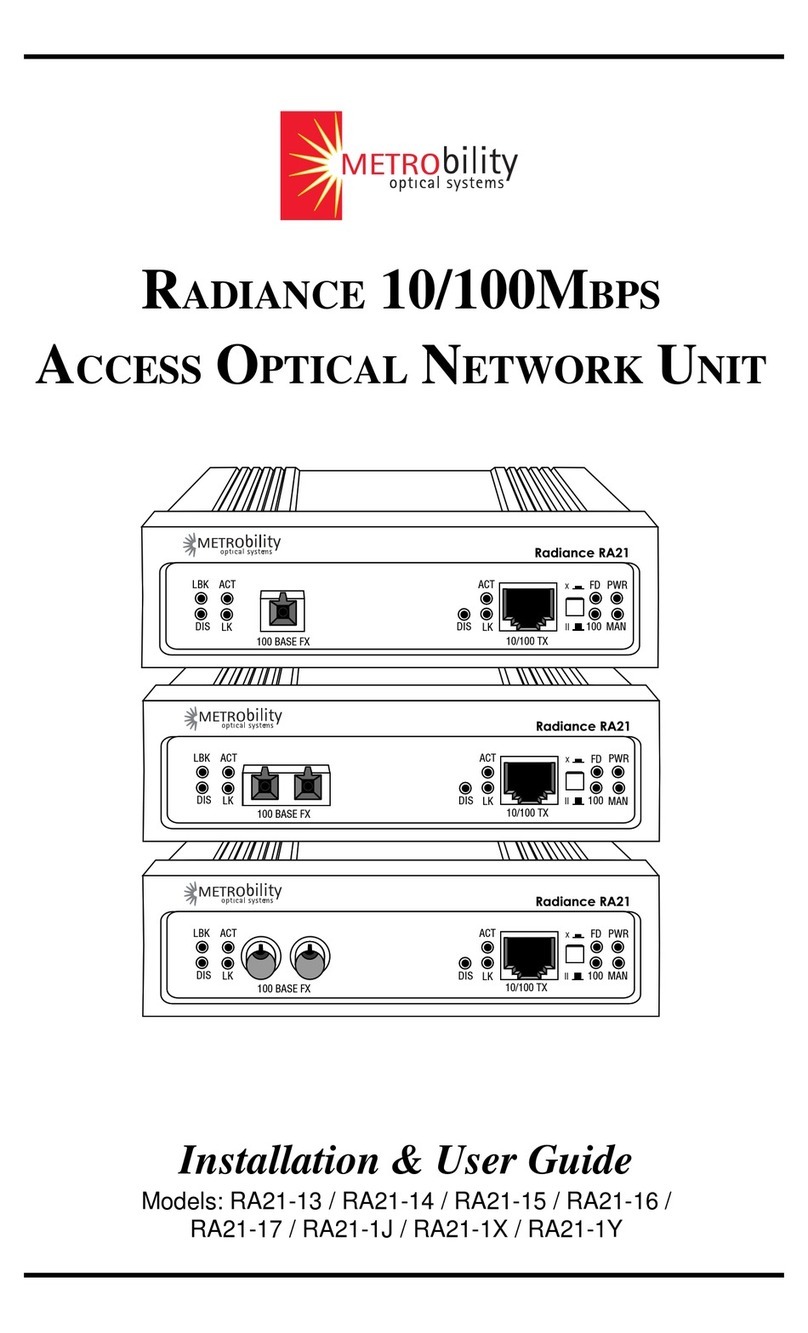
METRObility Optical Systems
METRObility Optical Systems RADIANCE 10/100MBPS ACCESS OPTICAL NETWORK... Installation & user guide
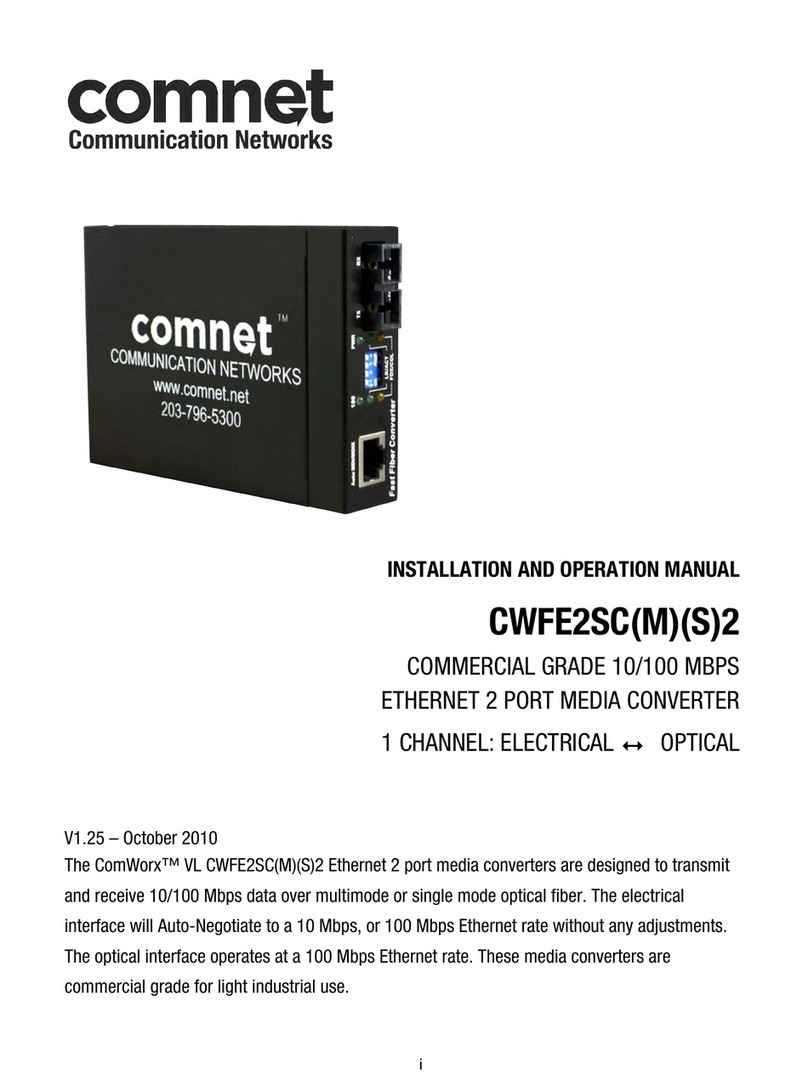
Comnet
Comnet CWFE2SC2 Installation and operation manual
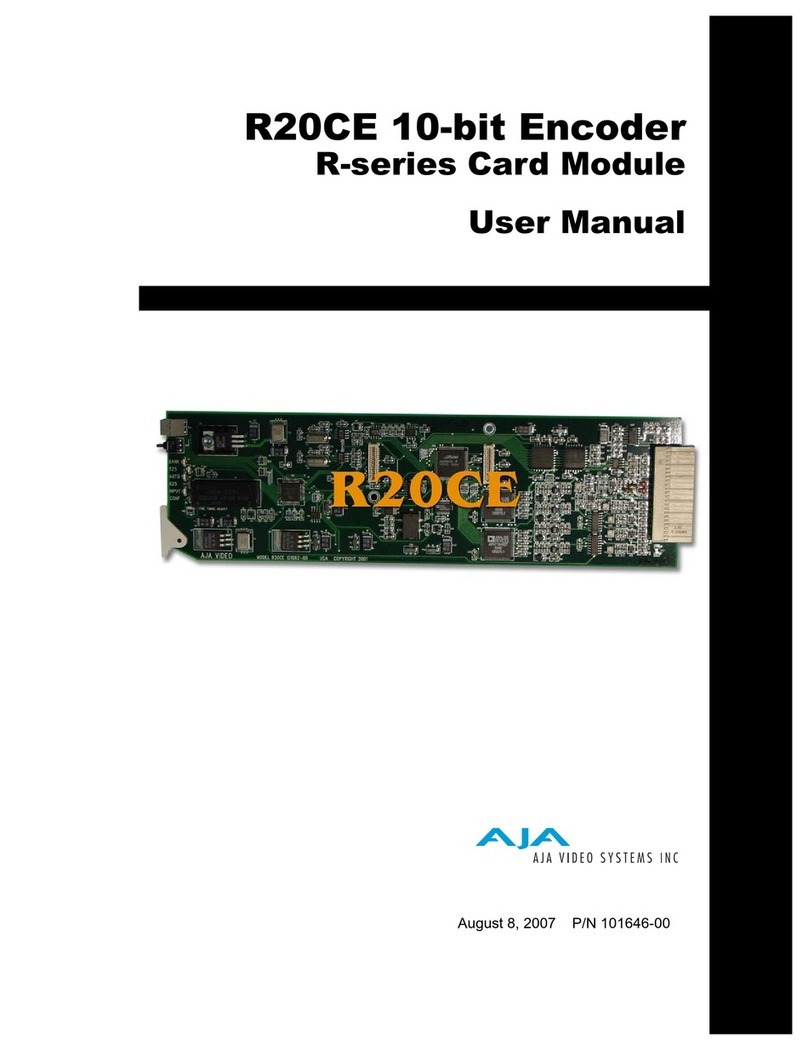
AJA
AJA R20CE user manual
